Conservation Genetics of Four Critically Endangered Greek Endemic Plants: A Preliminary Assessment
Abstract
:1. Introduction
2. Materials and Methods
2.1. Study Species
2.2. Specimens, DNA Extraction, Amplification, and Scoring of the ISSRs Markers
2.3. Scoring of the ISSR Markers and Analyses of Genetic Diversity
2.4. Environmental Data
2.5. Species Distribution Models
2.5.1. Model Parameterization and Evaluation
2.5.2. Model Projections
2.5.3. Area Range Change
3. Results
3.1. ISSR Polymorphism
3.2. Genetic Diversity
3.3. Species Distribution Modelling
4. Discussion
4.1. Genetic Diversity
4.2. Climate Change Impacts and Conservation Implications
4.3. Caveats-Concluding Remarks
Supplementary Materials
Author Contributions
Funding
Institutional Review Board Statement
Data Availability Statement
Acknowledgments
Conflicts of Interest
References
- Barthlott, W.; Mutke, J.; Rafiqpoor, D.; Kier, G.; Kreft, H. Global Centers of Vascular Plant Diversity. Nov. Acta Leopoldina 2005, 92, 61–83. [Google Scholar]
- Myers, N.; Mittermeier, R.A.; Mittermeier, C.G.; Da Fonseca, G.A.B.; Kent, J. Biodiversity hotspots for conservation priorities. Nature 2000, 403, 853–858. [Google Scholar] [CrossRef] [PubMed]
- Critical Ecosystem Partnership Fund. Mediterranean Basin Biodiversity Hotspot. Ecosystem Profile; Birdlife International: Cambridge, UK, 2017. [Google Scholar]
- Médail, F. The specific vulnerability of plant biodiversity and vegetation on Mediterranean islands in the face of global change. Reg. Environ. Chang. 2017, 17, 1775–1790. [Google Scholar] [CrossRef] [Green Version]
- Valente, L.M.; Vargas, P. Contrasting evolutionary hypotheses between two mediterranean-climate floristic hotspots: The Cape of southern Africa and the Mediterranean Basin. J. Biogeogr. 2013, 40, 2032–2046. [Google Scholar] [CrossRef]
- Rundel, P.W.; Arroyo, M.T.K.; Cowling, R.M.; Keeley, J.E.; Lamont, B.B.; Vargas, P. Mediterranean Biomes: Evolution of Their Vegetation, Floras, and Climate. Annu. Rev. Ecol. Evol. Syst. 2016, 47, 383–407. [Google Scholar] [CrossRef]
- Vargas, P.; Fernández-Mazuecos, M.; Heleno, R. Phylogenetic evidence for a Miocene origin of Mediterranean lineages: Species diversity, reproductive traits and geographical isolation. Plant Biol. 2018, 20, 157–165. [Google Scholar] [CrossRef]
- Thompson, J.D. Plant Evolution in the Mediterranean; Oxford University Press: Oxford, UK, 2005; ISBN 0198515332. [Google Scholar]
- Taberlet, P.; Fumagalli, L.; Wust-Saucy, A.G.; Cosson, J.F. Comparative phylogeography and postglacial colonization routes in Europe. Mol. Ecol. 1998. [Google Scholar] [CrossRef]
- Hewitt, G.M. Mediterranean Peninsulas: The Evolution of Hotspots. In Biodiversity Hotspots; Springer: Berlin/Heidelberg, Geramny, 2011; pp. 123–147. [Google Scholar]
- Petit, R.J.; Aguinagalde, I.; De Beaulieu, J.L.; Bittkau, C.; Brewer, S.; Cheddadi, R.; Ennos, R.; Fineschi, S.; Grivet, D.; Lascoux, M.; et al. Glacial refugia: Hotspots but not melting pots of genetic diversity. Science 2003. [Google Scholar] [CrossRef] [Green Version]
- Horne, D.J.; Griffiths, H.I.; Krystufek, B.; Reed, J.M. (Eds.) Balkan Biodiversity: Pattern and Process in the European Hotspot. J. Paleolimnol. 2007, 38, 609–611. [Google Scholar] [CrossRef]
- Tzedakis, P.C. The Balkans as Prime Glacial Refugial Territory of European Temperate Trees. In Balkan Biodiversity; Springer: Dordrecht, The Netherlands, 2004; pp. 49–68. [Google Scholar]
- Mansion, G.; Rosenbaum, G.; Schoenenberger, N.; Bacchetta, G.; Rosselló, J.A.; Conti, E. Phylogenetic analysis informed by geological history supports multiple, sequential invasions of the Mediterranean Basin by the angiosperm family Araceae. Syst. Biol. 2008, 57, 269–285. [Google Scholar] [CrossRef] [Green Version]
- Frajman, B.; Pachschwöll, C.; Schönswetter, P. Contributions to the knowledge of the flora of the dinarides (Balkan Peninsula). Phyt. Ann. Rei Bot. 2014. [Google Scholar] [CrossRef]
- Lakušić, D.; Liber, Z.; Nikolić, T.; Surina, B.; Kovačić, S.; Bogdanović, S.; Stefanović, S. Molecular phylogeny of the Campanula pyramidalis species complex (Campanulaceae) inferred from chloroplast and nuclear non-coding sequences and its taxonomic implications. Taxon 2013, 62, 505–524. [Google Scholar] [CrossRef] [Green Version]
- Surina, B.; Schönswetter, P.; Schneeweiss, G.M. Quaternary range dynamics of ecologically divergent species (Edraianthus serpyllifolius and E. tenuifolius, Campanulaceae) within the Balkan refugium. J. Biogeogr. 2011. [Google Scholar] [CrossRef]
- Surina, B.; Schneeweiss, G.M.; Glasnović, P.; Schönswetter, P. Testing the efficiency of nested barriers to dispersal in the Mediterranean high mountain plant Edraianthus graminifolius (Campanulaceae). Mol. Ecol. 2014. [Google Scholar] [CrossRef] [PubMed]
- Kutnjak, D.; Kuttner, M.; Niketić, M.; Dullinger, S.; Schönswetter, P.; Frajman, B. Escaping to the summits: Phylogeography and predicted range dynamics of Cerastium dinaricum, an endangered high mountain plant endemic to the western Balkan Peninsula. Mol. Phylogenet. Evol. 2014. [Google Scholar] [CrossRef]
- Pacifici, M.; Foden, W.B.; Visconti, P.; Watson, J.E.M.; Butchart, S.H.M.; Kovacs, K.M.; Scheffers, B.R.; Hole, D.G.; Martin, T.G.; Akçakaya, H.R.; et al. Assessing species vulnerability to climate change. Nat. Clim. Chang. 2015, 5, 215–224. [Google Scholar] [CrossRef]
- Giorgi, F.; Lionello, P. Climate change projections for the Mediterranean region. Glob. Planet. Chang. 2008, 63, 90–104. [Google Scholar] [CrossRef]
- Newbold, T. Future effects of climate and land-use change on terrestrial vertebrate community diversity under different scenarios. Proc. R. Soc. B Biol. Sci. 2018, 285. [Google Scholar] [CrossRef]
- Newbold, T.; Hudson, L.N.; Contu, S.; Hill, S.L.L.; Beck, J.; Liu, Y.; Meyer, C.; Phillips, H.R.P.; Scharlemann, J.P.W.; Purvis, A. Widespread winners and narrow-ranged losers: Land use homogenizes biodiversity in local assemblages worldwide. PLoS Biol. 2018, 16, e2006841. [Google Scholar] [CrossRef]
- Powers, R.P.; Jetz, W. Global habitat loss and extinction risk of terrestrial vertebrates under future land-use-change scenarios. Nat. Clim. Chang. 2019, 9, 323–329. [Google Scholar] [CrossRef]
- Li, D.; Olden, J.D.; Lockwood, J.L.; Record, S.; McKinney, M.L.; Baiser, B. Changes in taxonomic and phylogenetic diversity in the Anthropocene. Proc. R. Soc. B Biol. Sci. 2020, 287, 20200777. [Google Scholar] [CrossRef]
- Menéndez-Guerrero, P.A.; Green, D.M.; Davies, T.J. Climate change and the future restructuring of Neotropical anuran biodiversity. Ecography 2020, 43, 222–235. [Google Scholar] [CrossRef]
- Kougioumoutzis, K.; Kokkoris, I.P.; Panitsa, M.; Trigas, P.; Strid, A.; Dimopoulos, P. Spatial Phylogenetics, Biogeographical Patterns and Conservation Implications of the Endemic Flora of Crete (Aegean, Greece) under Climate Change Scenarios. Biology 2020, 9, 199. [Google Scholar] [CrossRef]
- Lavergne, S.; Thuiller, W.; Molina, J.; Debussche, M. Environmental and human factors influencing rare plant local occurrence, extinction and persistence: A 115-year study in the Mediterranean region. J. Biogeogr. 2005, 32, 799–811. [Google Scholar] [CrossRef]
- Zalasiewicz, J.; Waters, C.N.; Williams, M.; Barnosky, A.D.; Cearreta, A.; Crutzen, P.; Ellis, E.; Ellis, M.A.; Fairchild, I.J.; Grinevald, J.; et al. When did the Anthropocene begin? A mid-twentieth century boundary level is stratigraphically optimal. Quat. Int. 2015, 383, 196–203. [Google Scholar] [CrossRef] [Green Version]
- Nic Lughadha, E.; Bachman, S.P.; Leão, T.C.C.; Forest, F.; Halley, J.M.; Moat, J.; Acedo, C.; Bacon, K.L.; Brewer, R.F.A.; Gâteblé, G.; et al. Extinction risk and threats to plants and fungi. Plants People Planet 2020, 2, 389–408. [Google Scholar] [CrossRef]
- Le Roux, J.J.; Hui, C.; Castillo, M.L.; Iriondo, J.M.; Keet, J.H.; Khapugin, A.A.; Médail, F.; Rejmánek, M.; Theron, G.; Yannelli, F.A.; et al. Recent Anthropogenic Plant Extinctions Differ in Biodiversity Hotspots and Coldspots. Curr. Biol. 2019, 29, 2912–2918.e2. [Google Scholar] [CrossRef] [PubMed]
- López-Pujol, J.; Martinell, M.C.; Massó, S.; Blanché, C.; Sáez, L. The “paradigm of extremes”: Extremely low genetic diversity in an extremely narrow endemic species, Coristospermum huteri (Umbelliferae). Plant Syst. Evol. 2013, 299, 439–446. [Google Scholar] [CrossRef]
- Médail, F.; Baumel, A. Using phylogeography to define conservation priorities: The case of narrow endemic plants in the Mediterranean Basin hotspot. Biol. Conserv. 2018, 224, 258–266. [Google Scholar] [CrossRef]
- Andreou, M.; Delipetrou, P.; Kadis, C.; Tsiamis, G.; Bourtzis, K.; Georghiou, K. An integrated approach for the conservation of threatened plants: The case of Arabis kennedyae (Brassicaceae). Acta Oecol. 2011, 37, 239–248. [Google Scholar] [CrossRef]
- Dimopoulos, P.; Raus, T.; Bergmeier, E.; Constantinidis, T.; Iatrou, G.; Kokkini, S.; Strid, A.; Tzanoudakis, D. Vascular Plants of Greece: An Annotated Checklist; Botanical Garden and Botanical Museum: Berlin, Germany, 2013; Volume 46, pp. 1–372. [Google Scholar]
- Bilz, M.; Kell, S.P.; Maxted, N.; Lansdown, R.V. European Red List of Vascular Plants; Publications Office of the European Union: Luxembourg, 2011; ISBN 9789279201998. [Google Scholar]
- López-Vinyallonga, S.; López-Pujol, J.; Constantinidis, T.; Susanna, A.; Garcia-Jacas, N. Mountains and refuges: Genetic structure and evolutionary history in closely related, endemic Centaurea in continental Greece. Mol. Phylogenet. Evol. 2015, 92, 243–254. [Google Scholar] [CrossRef] [PubMed]
- Kozlowski, G.; Frey, D.; Fazan, L.; Egli, B.; Bétrisey, S.; Gratzfeld, J.; Garfì, G.; Pirintsos, S. The Tertiary relict tree Zelkova abelicea (Ulmaceae): Distribution, population structure and conservation status on Crete. Oryx 2014, 48, 80–87. [Google Scholar] [CrossRef] [Green Version]
- Christe, C.; Kozlowski, G.; Frey, D.; Fazan, L.; Bétrisey, S.; Pirintsos, S.; Gratzfeld, J.; Naciri, Y. Do living ex situ collections capture the genetic variation of wild populations? A molecular analysis of two relict tree species, Zelkova abelica and Zelkova carpinifolia. Biodivers. Conserv. 2014, 23, 2945–2959. [Google Scholar] [CrossRef] [Green Version]
- Fineschi, S.; Cozzolino, S.; Migliaccio, M.; Vendramin, G.G. Genetic variation of relic tree species: The case of Mediterranean Zelkova abelicea (Lam.) Boisser and Z. sicula Di Pasquale, Garfì and Quézel (Ulmaceae). For. Ecol. Manag. 2004, 197, 273–278. [Google Scholar] [CrossRef]
- Stathi, E.; Kougioumoutzis, K.; Abraham, E.M.; Trigas, P.; Ganopoulos, I.; Avramidou, E.V.; Tani, E. Population genetic variability and distribution of the endangered Greek endemic Cicer graecum under climate change scenarios. AoB Plants 2020, 12. [Google Scholar] [CrossRef] [PubMed]
- Fassou, G.; Kougioumoutzis, K.; Iatrou, G.; Trigas, P.; Papasotiropoulos, V. Genetic Diversity and Range Dynamics of Helleborus odorus subsp. cyclophyllus under Different Climate Change Scenarios. Forests 2020, 11, 620. [Google Scholar] [CrossRef]
- Walas, L.; Ganatsas, P.; IszkuLo, G.; Thomas, P.A.; Dering, M. Spatial genetic structure and diversity of natural populations of Aesculus hippocastanum L. In Greece. PLoS ONE 2019, 14, 1–27. [Google Scholar] [CrossRef] [Green Version]
- Drouzas, A.D.; Charitonidou, M.; Tsiftsis, S. Chloroplast DNA variation in Epipactis atrorubens populations from northern Greece. Bot. Lett. 2017, 164, 55–62. [Google Scholar] [CrossRef]
- Augustinos, A.; Sotirakis, K.; Trigas, P.; Kalpoutzakis, E.; Papasotiropoulos, V. Genetic Variation in Three Closely Related Minuartia (Caryophyllaceae) Species Endemic to Greece: Implications for Conservation Management. Folia Geobot. 2014, 49, 603–621. [Google Scholar] [CrossRef]
- Kougioumoutzis, K.; Kokkoris, I.P.; Panitsa, M.; Trigas, P.; Strid, A.; Dimopoulos, P. Plant Diversity Patterns and Conservation Implications under Climate-Change Scenarios in the Mediterranean: The Case of Crete (Aegean, Greece). Diversity 2020, 12, 270. [Google Scholar] [CrossRef]
- Van Proosdij, A.S.J.; Sosef, M.S.M.; Wieringa, J.J.; Raes, N. Minimum required number of specimen records to develop accurate species distribution models. Ecography 2016, 39, 542–552. [Google Scholar] [CrossRef]
- Dimopoulos, P.; Raus, T.; Bergmeier, E.; Constantinidis, T.; Iatrou, G.; Kokkini, S.; Strid, A.; Tzanoudakis, D. Vascular plants of Greece: An annotated checklist. Supplement. Willdenowia 2016, 46, 301–348. [Google Scholar] [CrossRef] [Green Version]
- Strid, A. Atlas of the Aegean Flora; Botanic Garden and Botanical Museum Berlin-Freie Universität Berlin: Berlin, Germany, 2016. [Google Scholar]
- Phitos, D.; Strid, A.; Snogerup, S.; Greuter, W. The Red Data Book of Rare and Threatened Plants of Greece; World Wide Fund for Nature: Gland, Switzerland, 1995; ISBN 9789607506047. [Google Scholar]
- Phitos, D.; Constantinidis, T.H.; Kamari, G. The Red Data Book of Rare and Threatened Plants of Greece, Volume II; Hellenic Botanical Society: Patras, Greece, 2009. [Google Scholar]
- De Montmollin, B.; Strahm, W. The Top 50 Mediterranean Island Plants: Wild Plants at the Brink of Extinction, and What Is Needed to Save Them; IUCN: Gland, Switzerland, 2005; ISBN 283170832X. [Google Scholar]
- Kaltsis, A.; Koutsovoulou, K.; Thanos, C.A. Aethionema retsina. In The Red Data Book of Rare and Threatened Plants of Greece, Volume I; Phitos, D., Constantinidis, T., Kamari, G., Eds.; Hellenic Βotanical Society: Patras, France, 2009; pp. 53–55. [Google Scholar]
- Constantinidis, T.; Kaltsis, A.; Karamplianis, T.; Tountas, T.; Pasoulas, X. Demonstration of the Biodiversity Action Planning Approach, to Benefit local Biodiversity on an Aegean Island, Skyros; Hellenic Society of Environment and Culture: Athens, Greece; National and Kapodistrian University of Athens: Athens, Greece, 2012; p. 99. [Google Scholar]
- Iatrou, G. Aethionema Retsina. (Errata Version Published in 2016). IUCN Red List Threat. Species 2006. [Google Scholar] [CrossRef]
- Trigas, P.; Kalpoutzakis, E.; Constantinidis, T. Two new Allium (A. sect. Cupanioscordum, Amaryllidaceae) species from Greece. Phytotaxa 2017, 297, 179. [Google Scholar] [CrossRef]
- Fournaraki, C.; Thanos, C.A. Bupleurum kakiskalae. In The Red Data Book of Rare and Threatened Plants of Greece, Volume I; Phitos, D., Constantinidis, T., Kamari, G., Eds.; Hellenic Βotanical Society: Patras, Greece, 2009; pp. 163–165. [Google Scholar]
- Fournaraki, C. Conservation of Threatened Plants of Crete—Seed Ecology, Operation and Management of a Gene Bank. Ph.D. Thesis, Department of Botany, Faculty of Biology, National and Kapodistrian University of Athens, Athens, Greece, 2010. (In Greek with English Abstract). [Google Scholar]
- Iatrou, G.; Kypriotakis, Z.; Fournaraki, C.; Kaltsis, A.; Koutsovoulou, K. Convolvulus argyrothamnos. Available online: https://dx.doi.org/10.2305/IUCN.UK.2018-1.RLTS.T61677A102932388.en (accessed on 11 January 2021).
- Phitos, D.; Greuter, W. Saponaria jagelii, a new species from the island of Elafonisos (Peloponnisos, Greece). Flora Mediterr. 1993, 3, 277–278. [Google Scholar]
- Iatrou, G. Saponaria jagelii. The IUCN Red List of Threatened Species 2013: e.T61639A50017799. Available online: http://dx.doi.org/10.2305/IUCN.UK.2013-2.RLTS.T61639A50017799.en (accessed on 5 February 2021).
- Winnepenninckx, B.; Backeljau, T.; De Wachter, R. Extraction of high molecular weight DNA from molluscs. Trends Genet. 1993. [Google Scholar] [CrossRef]
- Parmakelis, A.; Spanos, E.; Papagiannakis, G.; Louis, C.; Mylonas, M. Mitochondrial DNA phylogeny and morphological diversity in the genus Mastus (Beck, 1837): A study in a recent (Holocene) island group (Koufonisi, south-east Crete). Biol. J. Linn. Soc. 2003. [Google Scholar] [CrossRef] [Green Version]
- Dos Santos, L.F.; de Oliveira, E.J.; dos Santos Silva, A.; de Carvalho, F.M.; Costa, J.L.; Pádua, J.G. ISSR markers as a tool for the assessment of genetic diversity in Passiflora. Biochem. Genet. 2011, 49, 540–554. [Google Scholar] [CrossRef] [PubMed]
- Pe, P.R.S. GenAlEx 6.5: Genetic analysis in Excel. Population genetic software for teaching and research—An update. Bioinformatics 2012, 28, 2537. [Google Scholar]
- Krawczak, M.; Nikolaus, S.; von Eberstein, H.; Croucher, P.J.P.; El Mokhtari, N.E.; Schreiber, S. PopGen: Population-based recruitment of patients and controls for the analysis of complex genotype-phenotype relationships. Public Health Genom. 2006, 9, 55–61. [Google Scholar] [CrossRef]
- Hijmans, R.J.; Cameron, S.E.; Parra, J.L.; Jones, P.G.; Jarvis, A. Very high resolution interpolated climate surfaces for global land areas. Int. J. Climatol. 2005, 25, 1965–1978. [Google Scholar] [CrossRef]
- Karger, D.N.; Conrad, O.; Böhner, J.; Kawohl, T.; Kreft, H.; Soria-Auza, R.W.; Zimmermann, N.E.; Linder, H.P.; Kessler, M. Climatologies at high resolution for the earth’s land surface areas. Sci. Data 2017, 4, 170122. [Google Scholar] [CrossRef] [Green Version]
- Title, P.O.; Bemmels, J.B. ENVIREM: An expanded set of bioclimatic and topographic variables increases flexibility and improves performance of ecological niche modeling. Ecography 2017. [Google Scholar] [CrossRef] [Green Version]
- Hengl, T.; de Jesus, J.M.; Heuvelink, G.B.M.; Gonzalez, M.R.; Kilibarda, M.; Blagotić, A.; Shangguan, W.; Wright, M.N.; Geng, X.; Bauer-Marschallinger, B.; et al. SoilGrids250m: Global gridded soil information based on machine learning. PLoS ONE 2017, 12, e0169748. [Google Scholar] [CrossRef] [PubMed] [Green Version]
- Jarvis, A.; Reuter, H.I.; Nelson, A.; Guevara, E. Hole-filled SRTM for the globe Version 4. CGIAR CSI SRTM 90m Database 2008, 15, 25–54. [Google Scholar]
- Hijmans, R.J. Raster: Geographic Data Analysis and Modeling. R Package Version 3.4-5. Available online: https://CRAN.R-project.org/package=raster (accessed on 14 November 2020).
- Evans, J.S. spatialEco. R Package Version 1.3-4. Available online: https://github.com/jeffreyevans/spatialEco (accessed on 10 December 2020).
- Hiemstra, P.H.; Pebesma, E.J.; Twenhofel, C.J.W.; Heuvelink, G.B.M. Real-time automatic interpolation of ambient gamma dose rates from the Dutch Radioactivity Monitoring Network. Comput. Geosci. 2008. [Google Scholar] [CrossRef]
- McSweeney, C.F.; Jones, R.G.; Lee, R.W.; Rowell, D.P. Selecting CMIP5 GCMs for downscaling over multiple regions. Clim. Dyn. 2015, 44, 3237–3260. [Google Scholar] [CrossRef] [Green Version]
- Araújo, M.B.; Anderson, R.P.; Barbosa, A.M.; Beale, C.M.; Dormann, C.F.; Early, R.; Garcia, R.A.; Guisan, A.; Maiorano, L.; Naimi, B.; et al. Standards for distribution models in biodiversity assessments. Sci. Adv. 2019, 5, eaat4858. [Google Scholar] [CrossRef] [PubMed] [Green Version]
- Morales-Barbero, J.; Vega-Álvarez, J. Input matters matter: Bioclimatic consistency to map more reliable species distribution models. Methods Ecol. Evol. 2019. [Google Scholar] [CrossRef]
- Dormann, C.F.; Elith, J.; Bacher, S.; Buchmann, C.; Carl, G.; Carré, G.; Marquéz, J.R.G.; Gruber, B.; Lafourcade, B.; Leitão, P.J.; et al. Collinearity: A review of methods to deal with it and a simulation study evaluating their performance. Ecography 2013, 36, 027–046. [Google Scholar] [CrossRef]
- Naimi, B.; Hamm, N.A.S.; Groen, T.A.; Skidmore, A.K.; Toxopeus, A.G. Where is positional uncertainty a problem for species distribution modelling? Ecography 2014, 37, 191–203. [Google Scholar] [CrossRef]
- Breiner, F.T.; Nobis, M.P.; Bergamini, A.; Guisan, A. Optimizing ensembles of small models for predicting the distribution of species with few occurrences. Methods Ecol. Evol. 2018. [Google Scholar] [CrossRef] [Green Version]
- Breiner, F.T.; Guisan, A.; Nobis, M.P.; Bergamini, A. Including environmental niche information to improve IUCN Red List assessments. Divers. Distrib. 2017. [Google Scholar] [CrossRef] [Green Version]
- Breiner, F.T.; Guisan, A.; Bergamini, A.; Nobis, M.P. Overcoming limitations of modelling rare species by using ensembles of small models. Methods Ecol. Evol. 2015, 6, 1210–1218. [Google Scholar] [CrossRef]
- Lawler, J.J.; White, D.; Neilson, R.P.; Blaustein, A.R. Predicting climate-induced range shifts: Model differences and model reliability. Glob. Chang. Biol. 2006. [Google Scholar] [CrossRef] [Green Version]
- Barbet-Massin, M.; Jiguet, F.; Albert, C.H.; Thuiller, W. Selecting pseudo-absences for species distribution models: How, where and how many? Methods Ecol. Evol. 2012, 3, 327–338. [Google Scholar] [CrossRef]
- Valavi, R.; Elith, J.; Lahoz-Monfort, J.J.; Guillera-Arroita, G. blockCV: An r package for generating spatially or environmentally separated folds for k-fold cross-validation of species distribution models. Methods Ecol. Evol. 2019. [Google Scholar] [CrossRef] [Green Version]
- Dauby, G.; Stévart, T.; Droissart, V.; Cosiaux, A.; Deblauwe, V.; Simo-Droissart, M.; Sosef, M.S.M.; Lowry, P.P.; Schatz, G.E.; Gereau, R.E.; et al. ConR: An R package to assist large-scale multispecies preliminary conservation assessments using distribution data. Ecol. Evol. 2017. [Google Scholar] [CrossRef] [Green Version]
- Meyer, L.; Diniz-Filho, J.A.F.; Lohmann, L.G. A comparison of hull methods for estimating species ranges and richness maps. Plant Ecol. Divers. 2017, 10, 389–401. [Google Scholar] [CrossRef]
- Allouche, O.; Tsoar, A.; Kadmon, R. Assessing the accuracy of species distribution models: Prevalence, kappa and the true skill statistic (TSS). J. Appl. Ecol. 2006, 43, 1223–1232. [Google Scholar] [CrossRef]
- Raes, N.; Ter Steege, H. A null-model for significance testing of presence-only species distribution models. Ecography 2007, 30, 727–736. [Google Scholar] [CrossRef]
- Thuiller, W.; Lafourcade, B.; Engler, R.; Araújo, M.B. BIOMOD—A platform for ensemble forecasting of species distributions. Ecography 2009, 32, 369–373. [Google Scholar] [CrossRef]
- Di Cola, V.; Broennimann, O.; Petitpierre, B.; Breiner, F.T.; D’Amen, M.; Randin, C.; Engler, R.; Pottier, J.; Pio, D.; Dubuis, A.; et al. ecospat: An R package to support spatial analyses and modeling of species niches and distributions. Ecography 2017, 40, 774–787. [Google Scholar] [CrossRef]
- Liu, C.; Berry, P.M.; Dawson, T.P.; Pearson, R.G. Selecting thresholds of occurrence in the prediction of species distributions. Ecography 2005, 28, 385–393. [Google Scholar] [CrossRef]
- Liu, C.; White, M.; Newell, G. Selecting thresholds for the prediction of species occurrence with presence-only data. J. Biogeogr. 2013, 40, 778–789. [Google Scholar] [CrossRef]
- Liu, C.; Newell, G.; White, M. On the selection of thresholds for predicting species occurrence with presence-only data. Ecol. Evol. 2016. [Google Scholar] [CrossRef] [PubMed] [Green Version]
- Elith, J.; Kearney, M.; Phillips, S. The art of modelling range-shifting species. Methods Ecol. Evol. 2010, 1, 330–342. [Google Scholar] [CrossRef]
- Wright, S.A.; Hutchison, M.; Hale, M.L.; Gemmill, C.E.C.; de Lange, P.J.; Pelser, P.B. A preliminary conservation genetic study of Pittosporum obcordatum (Pittosporaceae), an endemic New Zealand species with a disjunct distribution. N. Zeal. J. Bot. 2017. [Google Scholar] [CrossRef] [Green Version]
- De Kort, H.; Prunier, J.G.; Ducatez, S.; Honnay, O.; Baguette, M.; Stevens, V.M.; Blanchet, S. Life history, climate and biogeography interactively affect worldwide genetic diversity of plant and animal populations. Nat. Commun. 2021. [Google Scholar] [CrossRef] [PubMed]
- Cronk, Q. Plant extinctions take time. Science 2016. [Google Scholar] [CrossRef]
- Halley, J.M.; Monokrousos, N.; Mazaris, A.D.; Vokou, D. Extinction debt in plant communities: Where are we now? J. Veg. Sci. 2017, 28, 459–461. [Google Scholar] [CrossRef] [Green Version]
- Halley, J.M.; Monokrousos, N.; Mazaris, A.D.; Newmark, W.D.; Vokou, D. Dynamics of extinction debt across five taxonomic groups. Nat. Commun. 2016, 7, 1–6. [Google Scholar] [CrossRef] [Green Version]
- Halley, J.M.; Van Houtan, K.S.; Mantua, N. How survival curves affect populations vulnerability to climate change. PLoS ONE 2018, 13, e0203124. [Google Scholar] [CrossRef] [PubMed]
- Liber, Z.; Surina, B.; Nikolić, T.; Škrtić, D.; Šatović, Z. Spatial distribution, niche ecology and conservation genetics of Degenia velebitica (Brassicaceae), a narrow endemic species of the north-western Dinaric Alps. Plant Syst. Evol. 2020, 306, 1–19. [Google Scholar] [CrossRef]
- Aavik, T.; Thetloff, M.; Träger, S.; Hernández-Agramonte, I.M.; Reinula, I.; Pärtel, M. Delayed and immediate effects of habitat loss on the genetic diversity of the grassland plant Trifolium montanum. Biodivers. Conserv. 2019, 28, 3299–3319. [Google Scholar] [CrossRef]
- Chen, J.; Gituru, W.R.; Liu, X.; Wang, Q. Genetic diversity in Isoetes yunguiensis, a rare and endangered endemic fern in China. Front. Biol. China 2007. [Google Scholar] [CrossRef]
- Wang, T.; Su, Y.; Ye, H.; Ouyang, P.; Jiang, Y.; Sun, Y.; Chen, G.; Deng, F.; Zhang, H. Genetic differentiation and conservation of 14 surviving individuals of Euryodendron excelsum endemic to China. Front. Biol. China 2006. [Google Scholar] [CrossRef]
- Urquía, D.; Pozo, G.; Gutierrez, B.; Rowntree, J.K.; Torres, M.d.L. Understanding the genetic diversity of the guayabillo (Psidium galapageium), an endemic plant of the Galapagos Islands. Glob. Ecol. Conserv. 2020. [Google Scholar] [CrossRef]
- Kougioumoutzis, K.; Kokkoris, I.P.; Panitsa, M.; Kallimanis, A.; Strid, A.; Dimopoulos, P. Plant Endemism Centres and Biodiversity Hotspots in Greece. Biology 2021, 10, 72. [Google Scholar] [CrossRef]
- Chapman, M.A.; Hiscock, S.J.; Filatov, D.A. The genomic bases of morphological divergence and reproductive isolation driven by ecological speciation in Senecio (Asteraceae). J. Evol. Biol. 2016. [Google Scholar] [CrossRef] [Green Version]
- Christe, C.; Kozlowski, G.; Frey, D.; Bétrisey, S.; Maharramova, E.; Garfì, G.; Pirintsos, S.; Naciri, Y. Footprints of past intensive diversification and structuring in the genus Zelkova (Ulmaceae) in south-western Eurasia. J. Biogeogr. 2014, 41, 1081–1093. [Google Scholar] [CrossRef] [Green Version]
- Nybom, H. Comparison of different nuclear DNA markers for estimating intraspecific genetic diversity in plants. Mol. Ecol. 2004. [Google Scholar] [CrossRef] [PubMed]
- Fernández-Mazuecos, M.; Jiménez-Mejías, P.; Rotllan-Puig, X.; Vargas, P. Narrow endemics to Mediterranean islands: Moderate genetic diversity but narrow climatic niche of the ancient, critically endangered Naufraga (Apiaceae). Perspect. Plant Ecol. Evol. Syst. 2014, 16, 190–202. [Google Scholar] [CrossRef]
- Forrest, A.; Escudero, M.; Heuertz, M.; Wilson, Y.; Cano, E.; Vargas, P. Testing the hypothesis of low genetic diversity and population structure in narrow endemic species: The endangered Antirrhinum charidemi (Plantaginaceae). Bot. J. Linn. Soc. 2017. [Google Scholar] [CrossRef] [Green Version]
- Armstrong, T.T.J.; De Lange, P.J. Conservation genetics of Hebe speciosa (Plantaginaceae) an endangered New Zealand shrub. Bot. J. Linn. Soc. 2005. [Google Scholar] [CrossRef] [Green Version]
- Spielman, D.; Brook, B.W.; Frankham, R. Most species are not driven to extinction before genetic factors impact them. Proc. Natl. Acad. Sci. USA 2004. [Google Scholar] [CrossRef] [Green Version]
- Jump, A.S.; Penuelas, J. Running to stand still: Adaptation and the response of plants to rapid climate change. Ecol. Lett. 2005, 8, 1010–1020. [Google Scholar] [CrossRef]
- Urban, M.C. Accelerating extinction risk from climate change. Science 2015, 348, 571–573. [Google Scholar] [CrossRef] [PubMed] [Green Version]
- Gray, A. The ecology of plant extinction: Rates, traits and island comparisons. Oryx 2019, 53, 424–428. [Google Scholar] [CrossRef] [Green Version]
- Vellend, M.; Baeten, L.; Becker-Scarpitta, A.; Boucher-Lalonde, V.; McCune, J.L.; Messier, J.; Myers-Smith, I.H.; Sax, D.F. Plant Biodiversity Change Across Scales During the Anthropocene. Annu. Rev. Plant Biol. 2017, 68, 563–586. [Google Scholar] [CrossRef] [Green Version]
- Enquist, B.J.; Feng, X.; Boyle, B.; Maitner, B.; Newman, E.A.; Jørgensen, P.M.; Roehrdanz, P.R.; Thiers, B.M.; Burger, J.R.; Corlett, R.T.; et al. The commonness of rarity: Global and future distribution of rarity across land plants. Sci. Adv. 2019, 5, eaaz0414. [Google Scholar] [CrossRef] [PubMed] [Green Version]
- Warren, R.; Vanderwal, J.; Price, J.; Welbergen, J.A.; Atkinson, I.; Ramirez-Villegas, J.; Osborn, T.J.; Jarvis, A.; Shoo, L.P.; Williams, S.E.; et al. Quantifying the benefit of early climate change mitigation in avoiding biodiversity loss. Nat. Clim. Chang. 2013, 3, 678–682. [Google Scholar] [CrossRef] [Green Version]
- Castellari, S.; Kurnik, B. Climate Change, Impacts and Vulnerability in Europe; European Environment Agency: Copenhagen, Denmark, 2017; ISBN 9789292138356. [Google Scholar]
- Nearing, M.A.; Pruski, F.F.; O’Neal, M.R. Expected climate change impacts on soil erosion rates: A review. J. Soil Water Conserv. 2004, 59, 43–50. [Google Scholar]
- Borrelli, P.; Robinson, D.A.; Panagos, P.; Lugato, E.; Yang, J.E.; Alewell, C.; Wuepper, D.; Montanarella, L.; Ballabio, C. Land use and climate change impacts on global soil erosion by water (2015–2070). Proc. Natl. Acad. Sci. USA 2020, 117, 21994–22001. [Google Scholar] [CrossRef]
- Trnka, M.; Kersebaum, K.C.; Eitzinger, J.; Hayes, M.; Hlavinka, P.; Svoboda, M.; Dubrovský, M.; Semerádová, D.; Wardlow, B.; Pokorný, E.; et al. Consequences of climate change for the soil climate in Central Europe and the central plains of the United States. Clim. Chang. 2013, 120, 405–418. [Google Scholar] [CrossRef] [Green Version]
- Newbold, T.; Oppenheimer, P.; Etard, A.; Williams, J.J. Tropical and Mediterranean biodiversity is disproportionately sensitive to land-use and climate change. Nat. Ecol. Evol. 2020. [Google Scholar] [CrossRef]
- Fenu, G.; Bacchetta, G.; Christodoulou, C.S.; Cogoni, D.; Fournaraki, C.; del Galdo Gian Pietro, G.; Gotsiou, P.; Kyratzis, A.; Piazza, C.; Vicens, M.; et al. A common approach to the conservation of threatened island vascular plants: First results in the mediterranean basin. Diversity 2020, 12, 157. [Google Scholar] [CrossRef] [Green Version]
- Plant, M.; Unit, C.; Management, N.R. PMRs in Western Crete. Plant Micro Reserves Theory Pract. 2013, 2000, 27–36. [Google Scholar]
- Laguna, E.; Fos, S.; Jiménez, J.; Volis, S. Role of micro-reserves in conservation of endemic, rare and endangered plants of the Valencian region (Eastern Spain). Isr. J. Plant Sci. 2016, 63, 320–332. [Google Scholar] [CrossRef]
- Nazareno, A.G.; Bemmels, J.B.; Dick, C.W.; Lohmann, L.G. Minimum sample sizes for population genomics: An empirical study from an Amazonian plant species. Mol. Ecol. Resour. 2017. [Google Scholar] [CrossRef]
- Kougioumoutzis, K.; Kokkoris, I.P.; Panitsa, M.; Strid, A.; Dimopoulos, P. Extinction Risk Assessment of the Greek Endemic Flora. Biology 2021, 10, 195. [Google Scholar] [CrossRef]
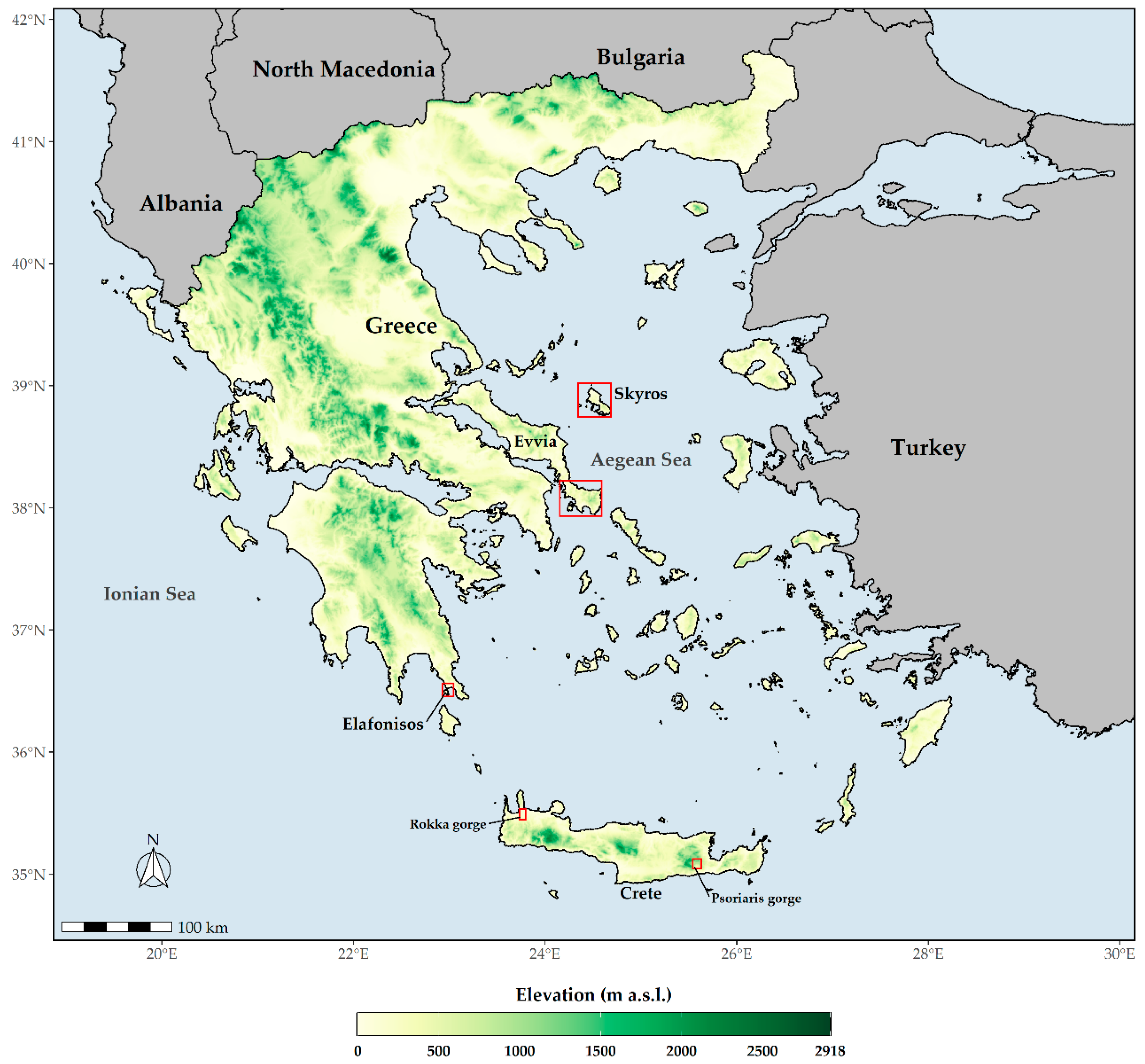
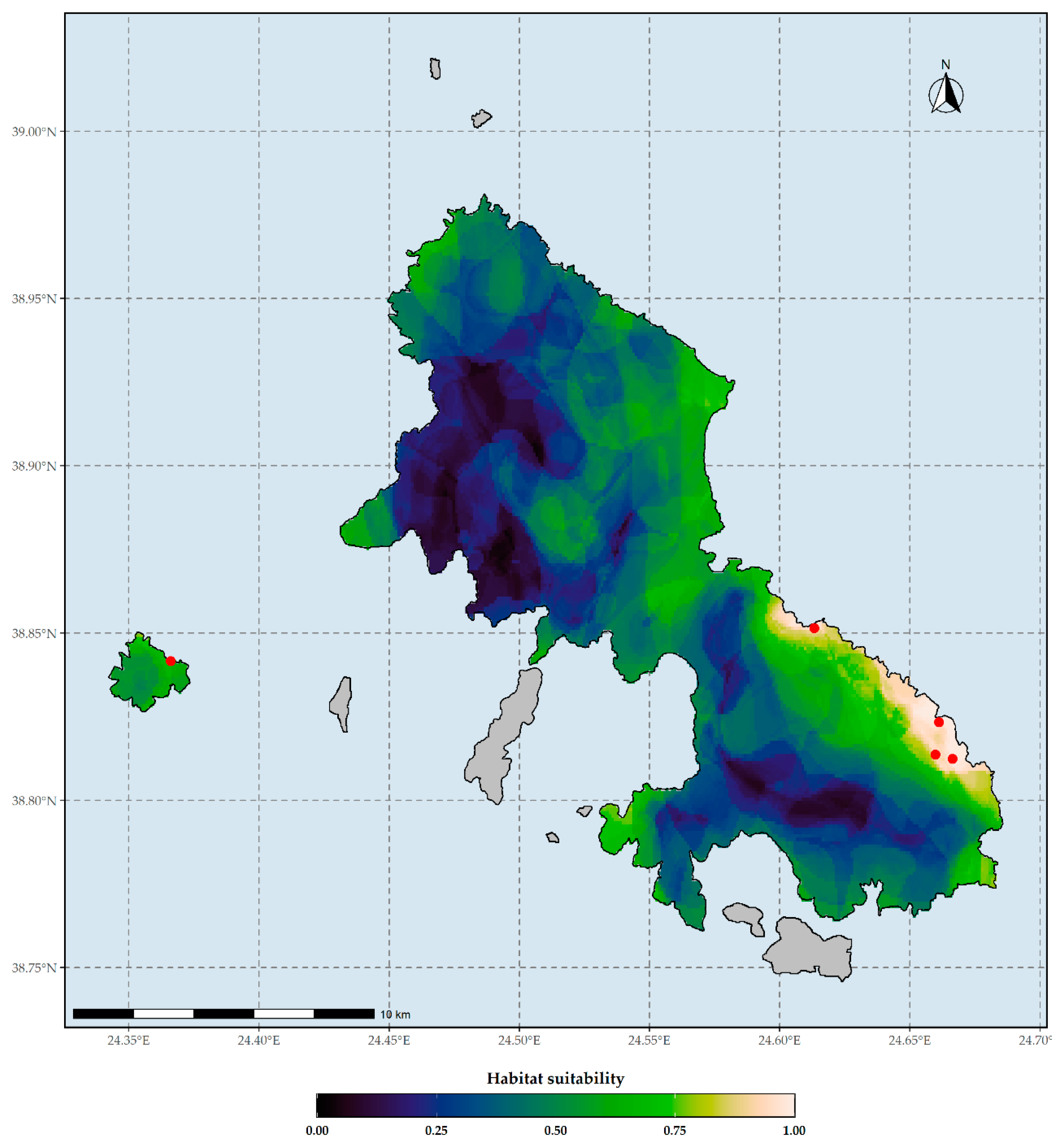
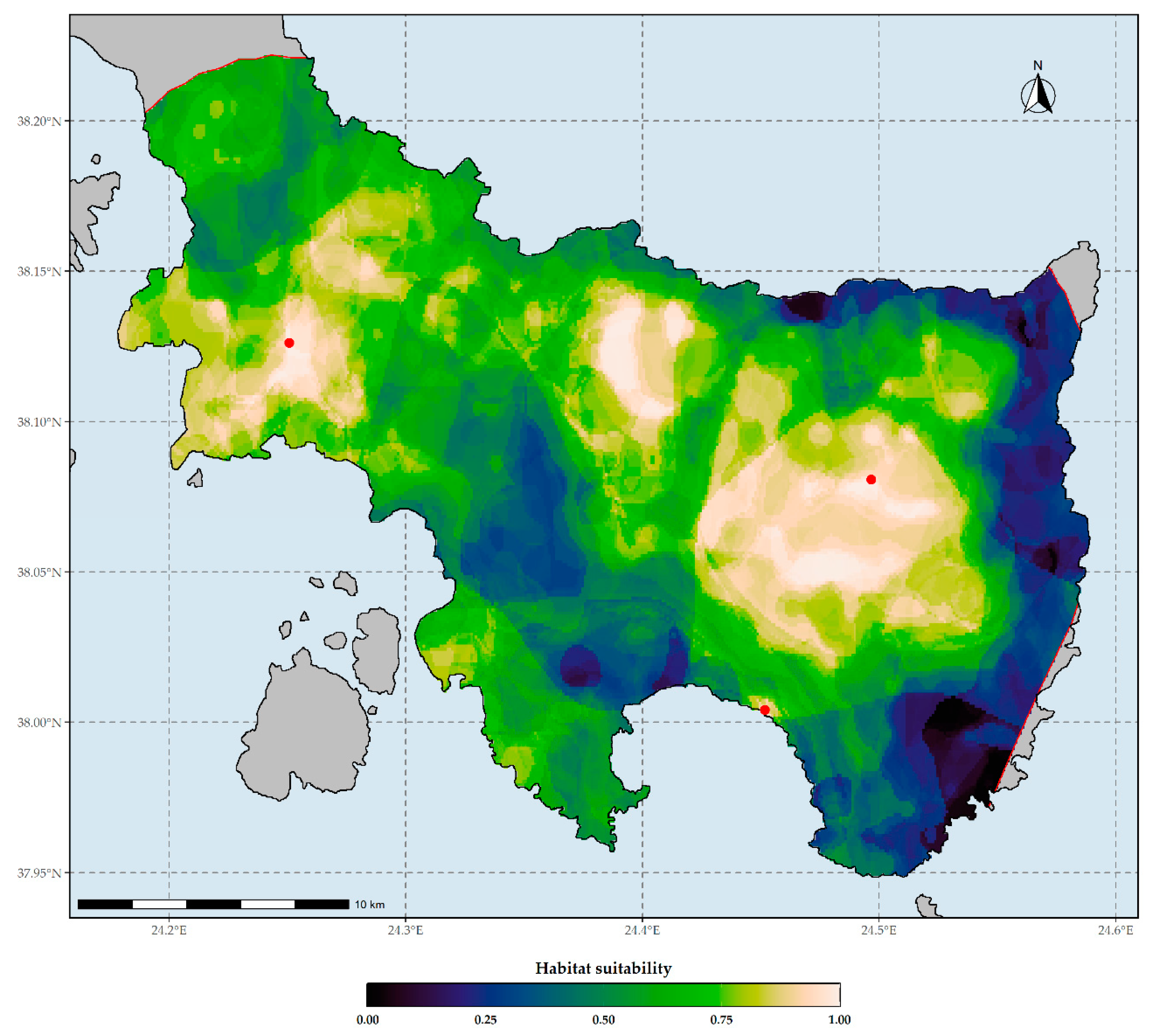
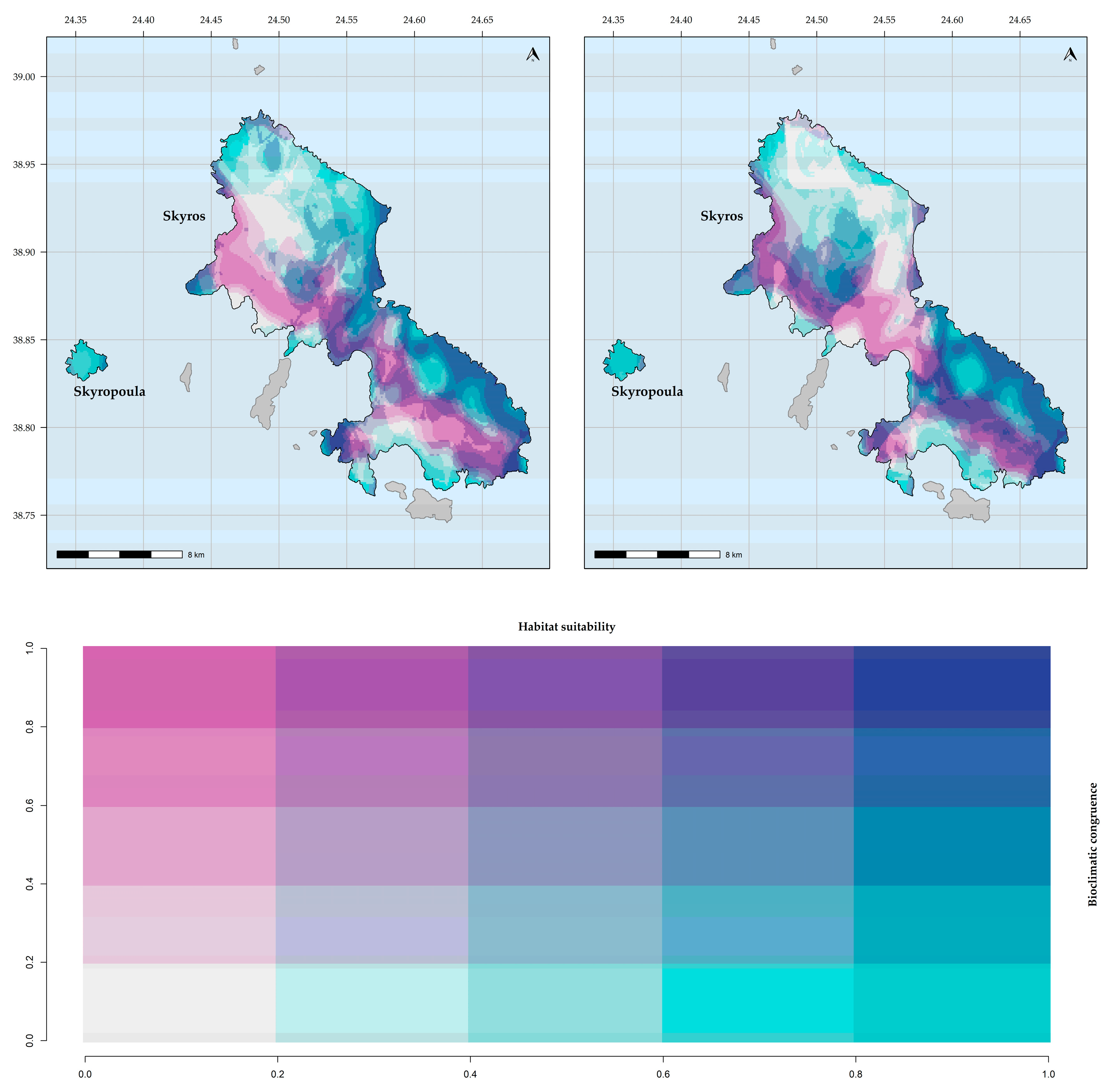
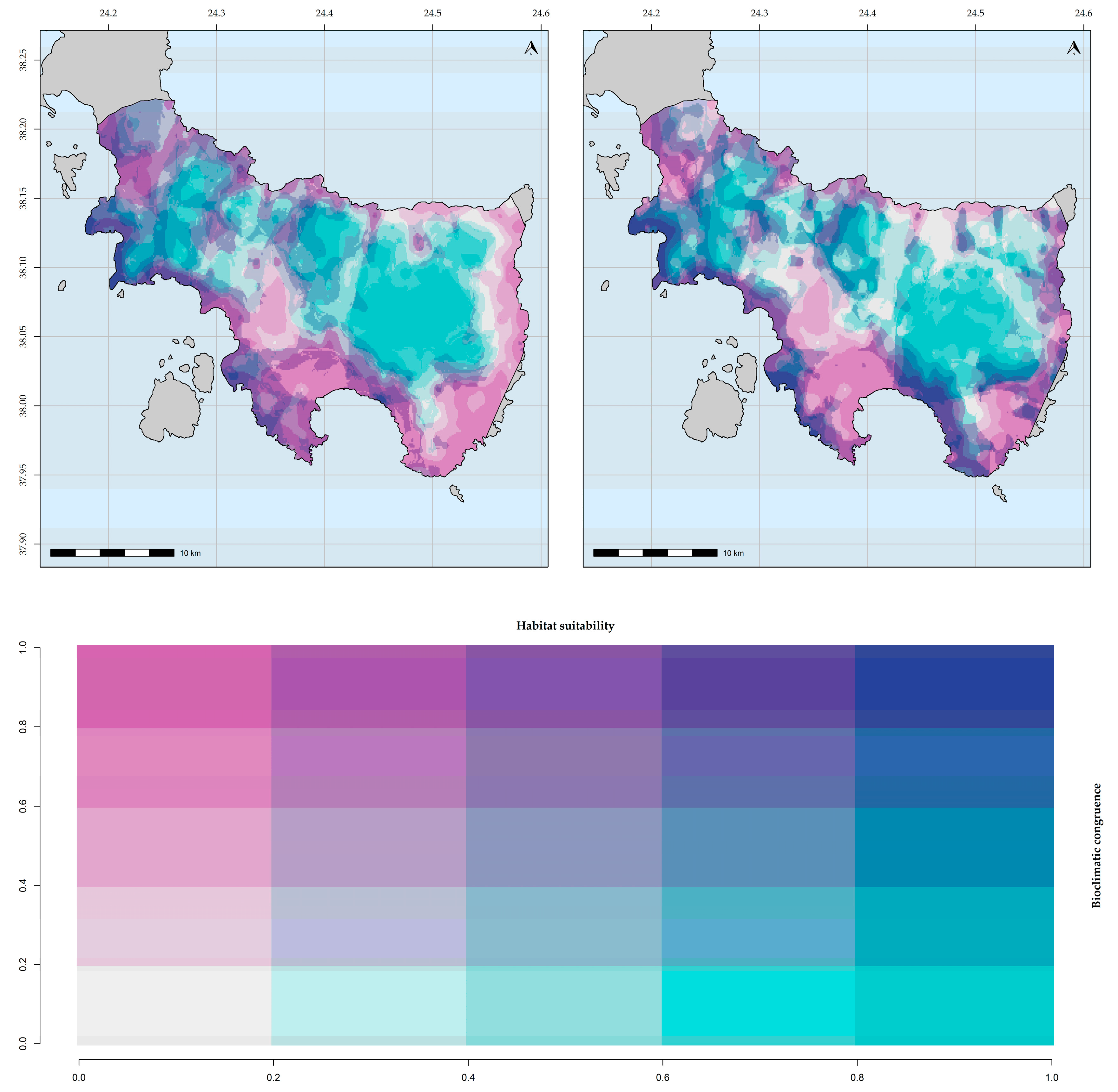
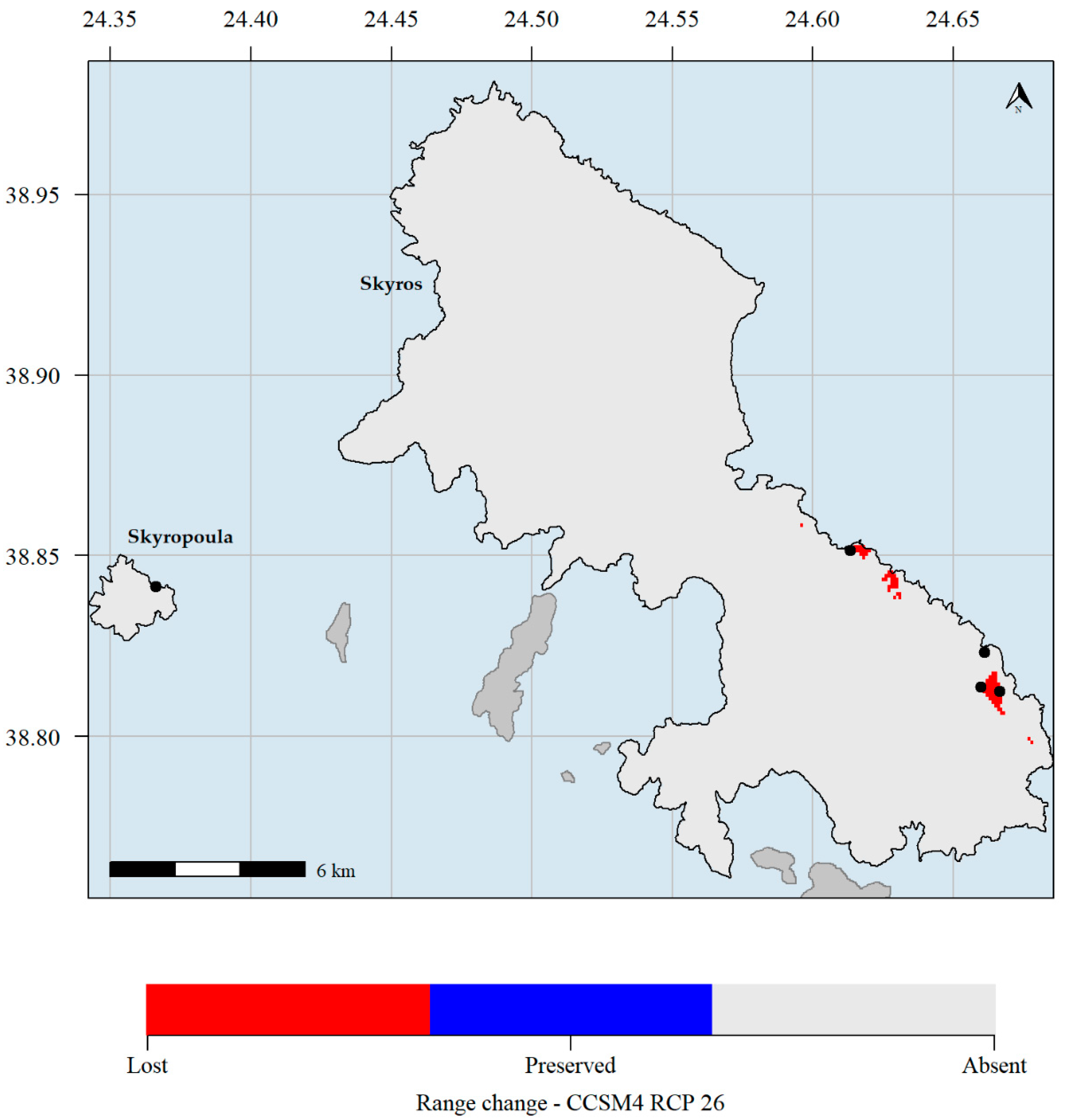

| Species | Locality | N | ISSR |
|---|---|---|---|
| Allium iatrouinum (8) | Evvia | 6 | 6 |
| Saponaria jagelii (8) | Elafonisos | 7 | 8 |
| Convolvulus argyrothamnos (2) | Rokka gorge, Crete | 2 | 13 |
| Aethionema retsina (3) | Skyros | 3 | 8 |
| ISSR | Genus | ISSR Sequence | NoB | SR | PCR |
|---|---|---|---|---|---|
| UBC 861 | Convolvulus | (ACC)6 | 2 | 257–664 | T: 55.0 °C, MgCl2: 2.5 mM, DNA: 15 ng, 37 cycles |
| UBC 841 | Convolvulus | (GA)8YC | 8 | 153–1157 | T: 50.0 °C, MgCl2: 2.5 mM, DNA: 15 ng, 37 cycles |
| Aethionema | 8 | 166–1583 | T: 50.0 °C, MgCl2: 2.5 mM, DNA: 15 ng, 37 cycles | ||
| Saponaria | 11 | 315–2350 | T: 48.0 °C, MgCl2: 2.5 mM, DNA: 20 ng, 37 cycles | ||
| Allium | 6 | 487–1047 | T: 51.0 °C, MgCl2: 2.5 mM, DNA: 15 ng, 39 cycles | ||
| UBC 810 | Convolvulus | (GA)8T | 15 | 306–1618 | T: 53.5 °C, MgCl2: 2.5 mM, DNA: 15 ng, 37 cycles |
| Saponaria | 7 | 275–1267 | T: 50.0 °C, MgCl2: 2.5 mM, DNA: 20 ng, 39 cycles | ||
| Allium | 10 | 469–1378 | T: 50.0 °C, MgCl2: 2.5 mM, DNA: 15 ng, 39 cycles | ||
| UBC 807 | Convolvulus | (AG)8T | 3 | 385–1023 | T: 50.0 °C, MgCl2: 2.5 mM, DNA: 15 ng, 37 cycles |
| Aethionema | 5 | 796–1835 | T: 51.5 °C, MgCl2: 2.5 mM, DNA: 15 ng, 37 cycles | ||
| Saponaria | 5 | 200–700 | T: 53.0 °C, MgCl2: 2.5 mM, DNA: 20 ng, 39 cycles | ||
| Allium | 7 | 306–1209 | T: 51.0 °C, MgCl2: 1.5 mM, DNA: 15 ng, 39 cycles | ||
| UBC 808 | Convolvulus | (AG)8C | 16 | 218–1013 | T: 51.5 °C, MgCl2: 2.5 mM, DNA: 15 ng, 37 cycles |
| Saponaria | 8 | 420–1500 | T: 51.0 °C, MgCl2: 2.0 mM, DNA: 20 ng, 39cycles | ||
| Allium | 9 | 443–1470 | T: 51.0 °C, MgCl2: 1.5 mM, DNA: 15 ng, 39 cycles | ||
| UBC 812 | Convolvulus | (GA)8A | 8 | 403–1141 | T: 50.0 °C, MgCl2: 2.5 mM, DNA: 15 ng, 37 cycles |
| Saponaria | 6 | 286–1432 | T: 51.0 °C, MgCl2: 2.5 mM, DNA: 20 ng, 39 cycles | ||
| Allium | 7 | 240–2402 | T: 51.0 °C, MgCl2: 2.0 mM, DNA: 15 ng, 39 cycles | ||
| UBC 811 | Convolvulus | (GA)8C | 11 | 323–1172 | T: 50.0 °C, MgCl2: 2.5 mM, DNA: 15 ng, 37 cycles |
| Aethionema | 5 | 222–785 | T: 50.0 °C, MgCl2: 2.5 mM, DNA: 15 ng, 37 cycles | ||
| Saponaria | 7 | 469–1835 | T: 48.0 °C, MgCl2: 2.5 mM, DNA: 20 ng, 37 cycles | ||
| UBC 825 | Convolvulus | (AC)8T | 5 | 488–1260 | T: 50.0 °C, MgCl2: 2.5 mM, DNA: 15 ng, 37 cycles |
| Aethionema | 3 | 487–1018 | T: 50.0 °C, MgCl2: 2.5 mM, DNA: 15 ng, 37 cycles | ||
| UBC 844 | Convolvulus | (CT)8RC | 7 | 334–982 | T: 54.0 °C, MgCl2: 2.5 mM, DNA: 15 ng, 37 cycles |
| UBC 818 | Convolvulus | (CA)8G | 12 | 450–1333 | T: 45.0 °C, MgCl2: 2.5 mM, DNA: 15 ng, 37 cycles |
| Aethionema | 4 | 512–1367 | T: 45.0 °C, MgCl2: 2.5 mM, DNA: 15 ng, 37 cycles | ||
| UBC 815 | Aethionema | (CT)8G | 3 | 796–1663 | T: 45.0 °C, MgCl2: 2.5 mM, DNA: 15 ng, 37 cycles |
| UBC 880 | Convolvulus | (GGAGA)3 | 4 | 665–1192 | T: 45.0 °C, MgCl2: 2.5 mM, DNA: 15 ng, 37 cycles |
| Aethionema | 3 | 836–1238 | T: 45.0 °C, MgCl2: 2.5 mM, DNA: 15 ng, 37 cycles | ||
| Saponaria | 8 | 355–1490 | T: 50.0 °C, MgCl2: 2.5 mM, DNA: 20 ng, 39 cycles | ||
| UBC 826 | Saponaria | (AC)8C | 6 | 403–1640 | T: 53.0 °C, MgCl2: 1.5 mM, DNA: 20 ng, 39 cycles |
| Allium | 9 | 1003–2344 | T: 52.0 °C, MgCl2: 1.5 mM, DNA: 15 ng, 39 cycles |
| Species | NoB | na | ne | h | I | PPB | He | uHe |
|---|---|---|---|---|---|---|---|---|
| Aethionema | 31 | 1.645 | 1.412 | 0.242 | 0.360 | 64.5 | 0.242 | 0.290 |
| Allium | 47 | 1.723 | 1.514 | 0.290 | 0.424 | 72.3 | 0.290 | 0.319 |
| Convolvulus | 91 | 1.582 | 1.412 | 0.241 | 0.352 | 58.2 | 0.241 | 0.322 |
| Saponaria | 58 | 1.517 | 1.434 | 0.232 | 0.329 | 51.7 | 0.232 | 0.254 |
| Variable | Aethionema retsina | Allium iatrouinum | ||
|---|---|---|---|---|
| WC | CH | WC | CH | |
| AIT | - | - | 0.420 | - |
| Aspect | 0.648 | 0.516 | - | - |
| CEC | 0.515 | 0.517 | 0.353 | 0.429 |
| CLP | 0.551 | 0.548 | 0.531 | 0.497 |
| CNT | - | - | - | 0.548 |
| CRF | 0.519 | 0.540 | - | 0.335 |
| HLI | 0.618 | 0.553 | 0.510 | 0.618 |
| ISO | - | 0.419 | 0.510 | - |
| MDR | - | 0.422 | - | - |
| ORC | 0.403 | 0.794 | - | 0.373 |
| PET | 0.509 | - | - | - |
| PETCOLD | - | - | 0.525 | 0.570 |
| PETDRY | - | - | 0.357 | - |
| PS | 0.397 | - | 0.614 | - |
| Slope | - | 0.485 | - | 0.482 |
| SLT | - | - | - | 0.369 |
| Temp | 0.506 | 0.427 | 0.561 | - |
| TPI | 0.490 | - | 0.659 | 0.667 |
Publisher’s Note: MDPI stays neutral with regard to jurisdictional claims in published maps and institutional affiliations. |
© 2021 by the authors. Licensee MDPI, Basel, Switzerland. This article is an open access article distributed under the terms and conditions of the Creative Commons Attribution (CC BY) license (https://creativecommons.org/licenses/by/4.0/).
Share and Cite
Kougioumoutzis, K.; Kotsakiozi, P.; Stathi, E.; Trigas, P.; Parmakelis, A. Conservation Genetics of Four Critically Endangered Greek Endemic Plants: A Preliminary Assessment. Diversity 2021, 13, 152. https://doi.org/10.3390/d13040152
Kougioumoutzis K, Kotsakiozi P, Stathi E, Trigas P, Parmakelis A. Conservation Genetics of Four Critically Endangered Greek Endemic Plants: A Preliminary Assessment. Diversity. 2021; 13(4):152. https://doi.org/10.3390/d13040152
Chicago/Turabian StyleKougioumoutzis, Konstantinos, Panayiota Kotsakiozi, Efthalia Stathi, Panayiotis Trigas, and Aristeidis Parmakelis. 2021. "Conservation Genetics of Four Critically Endangered Greek Endemic Plants: A Preliminary Assessment" Diversity 13, no. 4: 152. https://doi.org/10.3390/d13040152
APA StyleKougioumoutzis, K., Kotsakiozi, P., Stathi, E., Trigas, P., & Parmakelis, A. (2021). Conservation Genetics of Four Critically Endangered Greek Endemic Plants: A Preliminary Assessment. Diversity, 13(4), 152. https://doi.org/10.3390/d13040152








